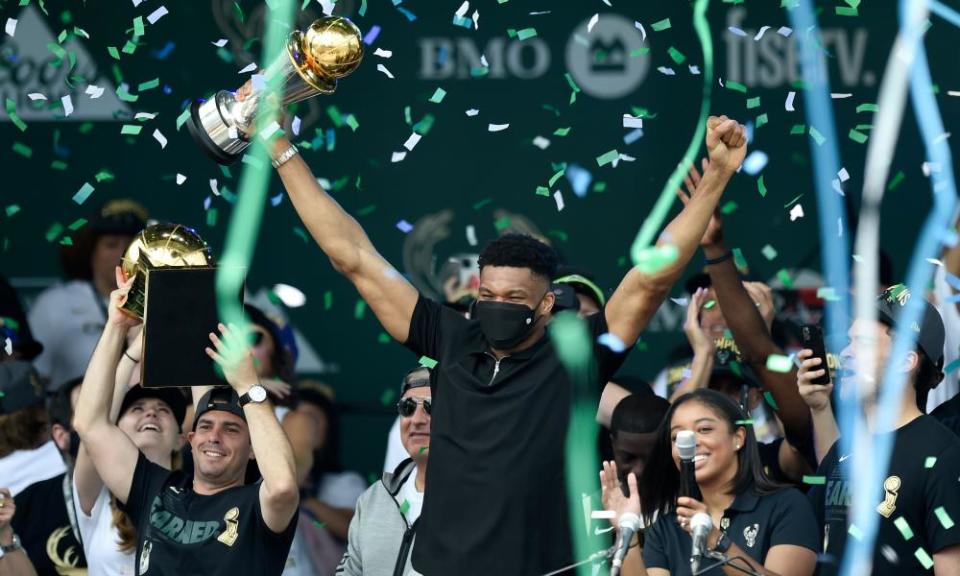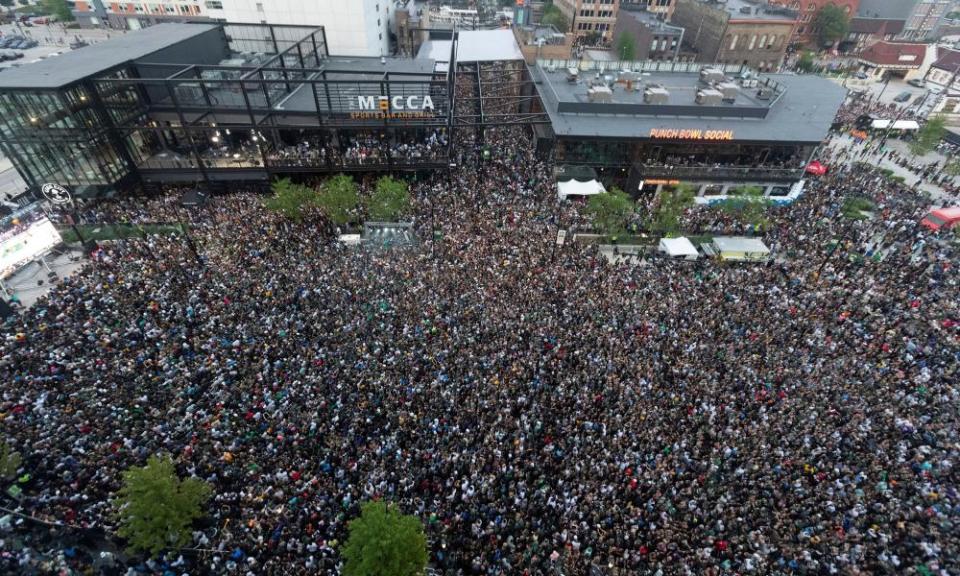‘This belongs to all of us’: Milwaukee Bucks victory a unifying force for city

Jabari Thompson had never seen an event bring the city of Milwaukee together like its NBA championship has done. It’s a victory for the basketball team – its first title in 50 years – but an even bigger win for a city that has sorely needed a moment to celebrate, he said.
“I feel like I was out there playing. Like I beat the Phoenix Suns, like we all did, and this win belongs to all of us,” said Thompson, 27.
Related: The scary thing about Giannis’ first NBA title? At 26 he is only getting better
On Thursday, confetti rained down in sheets as a victory parade wound through downtown Milwaukee and ended in the city’s Deer District, a 30-acre development surrounding the Fiserv Forum, where the Bucks on Tuesday defeated the Phoenix Suns to claim the title.
An estimated 100,000 fans flocked to the Deer District to witness the final contest of the series – a crowd size on par with the population of Wisconsin’s fourth largest city.
It was a storybook ending for one of the league’s smallest markets and a team national sports writers all but counted out last month, when star player Giannis Antetokounmpo suffered what appeared to be a season-ending knee injury.
But Antetokounmpo returned. And he dominated. After dropping the first two games in the series to the Suns, the Bucks roared back, winning the next four games en route to the championship. Antetokounmpo exploded in game six, carrying his team with 50 points on his way to being named the finals MVP.

It’s an unlikely triumph for a midwestern, rust belt city that in many ways sees itself as an underdog – a place that embraces its blue-collar roots and the workers who drove the industries that made it famous.
“In Milwaukee, we’re proud of being this hardscrabble place where we fight through these awful winters. We don’t have the glitz and glamour. We don’t have outsized wealth. What we have is an image of Milwaukee as a place where people work hard, take care of their families, and it’s enough to just go home at the end of the night and kick back with a beer,” said Michael Mirer, a visiting assistant professor who teaches sports media at the University of Wisconsin – Milwaukee.
Those traits are part reason why fans gravitate toward athletes like Bobby Portis, who passed on more lucrative offers to sign with the Bucks and called himself a “blue-collar player” in a “blue-collar city”, said Mirer.
“Sports fandom isn’t about the team or the players or the coaches. It’s about us. It’s about the bonds we form within our own communities and the values we see reflected on screen. So when a player or team reflects our community values, we respond to them more positively, “ Mirer said.
If only for a moment, the Bucks’ success represented a unifying force in a city that in some ways has been defined by its political and racial division. That point wasn’t lost on John Hoogland, who was nine years old when the Bucks seized their last championship.
“That win was great, but this one is even more special. Talk about diversity, this is really opening up our city. Look at this crowd. Look at how happy everybody is,” said Hoogland.
Milwaukee has been ranked as one of the nation’s most segregated metro areas and one its most politically polarized. The Bucks were touched personally by police violence in 2018, when one of its players, Sterling Brown, was tasered and arrested by Milwaukee police after he parked illegally in a handicap-accessible spot. After news broke of the incident, the Bucks were unequivocal in their support for Brown and for racial justice.
“The abuse and intimidation that Sterling experienced at the hands of Milwaukee police was shameful and inexcusable. Sterling has our full support as he shares his story and takes action to provide accountability,” read the statement.
Since then, the Bucks haven’t shied away from difficult conversations. Last year, after police shot Jacob Blake in nearby Kenosha, the team boycotted game five of the playoffs against Orlando, prompting other teams to follow suit and effectively shutting down the league. After the death of George Floyd, Bucks players took to the streets in support of Black Lives Matter.
For Milwaukee fans, the championship doesn’t negate the progress that’s still needed in the city, but after a year marred by racial unrest and a devastating pandemic, the win felt like a much needed reprieve.

“The pandemic took so much from this city. People were out of work, tips were down. We needed this positivity bad,” said Gregory Solomon, 54, as he toted a cart stacked with memorabilia – including a photo of himself alongside Antetokounmpo when he spotted the star in Walmart.
Cheering for the Bucks, Solomon said, rousted him from bed – where he’d been waylaid by an injury – and got him moving again.
“I just feel so good right now, I can’t even tell you,” said Solomon.
Kimberly Rohde, who is 40 years old and said she’s been a fan since she first saw a ball, was happy to bask in the moment.
“This goes deep,” she said. She said loves the Packers, the state’s football team, “but this happened in our city. It’s our win. It’s powerful.”

 Yahoo Sport
Yahoo Sport 





































